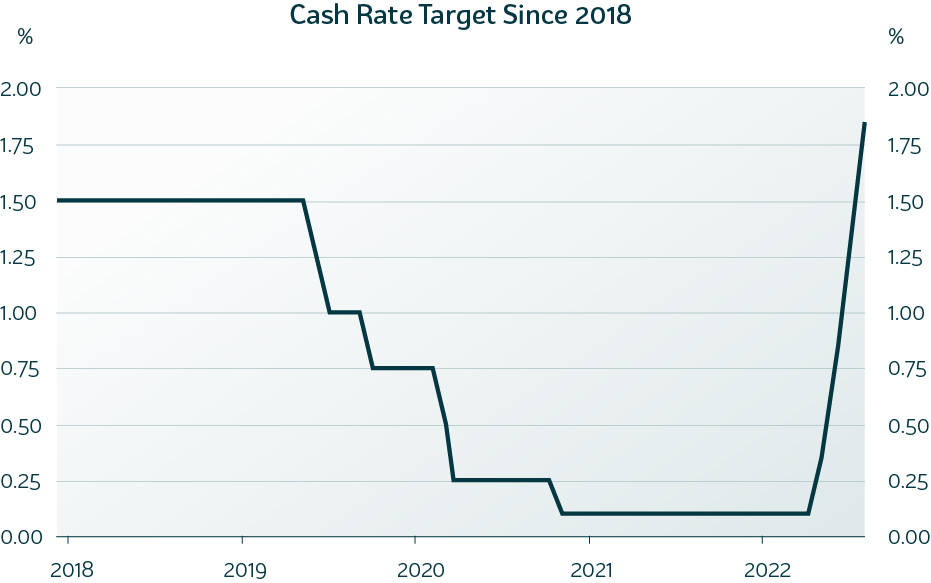Market Overview Financial Year 2021‑22
31 August 2022Section Heading
Key Points
- Market volatility has been a key theme impacting superannuation fund returns in the 2021-22 financial year.
- COVID-19 and other global events continue to impact on financial markets.
- The combination of high inflation, tighter monetary policy and aggressive central bank actions, rising risks to economic growth and the possibility of recession have proven very challenging for financial markets.
- Difficult market conditions resulted in all Super SA investment options, except Cash, posting negative returns for the financial year.
- The market expects the Reserve Bank of Australia will increase the cash rate towards 3.0% (instead of 2.0% which was reported in the previous quarter).
- Triple S (untaxed) Balanced Default option returned -6.9% for the quarter and -6.4% for the 2021-22 financial year.
- Over a 10-year investment horizon Super SA members have experienced positive returns, with Triple S (untaxed) Balanced Default option returning 8.3% p.a. to 30 June 2022.

Triple S returns to 30 June 2022
|
Investment option |
3 months |
1 year |
3 years |
5 years |
10 years |
|
Cash |
0.1 |
0.1 |
0.4 |
1.0 |
1.8 |
|
Capital Defensive |
-4.0 |
-6.4 |
0.4 |
2.3 |
3.9 |
|
Stable |
-5.1 |
-6.9 |
1.4 |
3.4 |
5.4 |
|
Moderate |
-5.8 |
-6.2 |
2.5 |
4.6 |
6.8 |
|
Socially Responsible |
-8.1 |
-5.8 |
4.1 |
5.9 |
8.0 |
|
Balanced |
-6.9 |
-6.4 |
4.3 |
6.1 |
8.3 |
|
High Growth |
-7.5 |
-6.1 |
4.9 |
7.0 |
9.8 |
Returns net of fees and gross of tax, based on Super SA unit pricing formula.
The challenges in financial markets that have affected Super SA’s investment options are namely:
- Higher-than-expected inflation
- Rising interest rates
- Sharp increases in interest rates have led to declines in bond prices
- Falling equity valuations and the risk of recession.
Higher-than-expected inflation
Rising inflation means the price of goods and services has increased. This occurred primarily because of supply chain constraints due to two key issues:
- Russia’s invasion of Ukraine in late February 2022, and subsequent trade restrictions and sanctions, put further upward pressure on inflation, particularly relating to global supply of energy and food.
- Major lockdowns to contain COVID outbreaks, notably China continuing to pursue zero-COVID strategy, and worker shortages.
The supply chain issues meant there were fewer goods for consumers to buy, causing prices to rise. Inflation rose throughout the year; in the US and the UK inflation is now at a 40 year high of 9.4%. Australia’s inflation was 6.1% at the end of the 2021-22 financial year, considerably higher than the central bank 2-3% target range.
Rising interest rates
Central banks have tried to bring inflation under control by raising interest rates. This effectively reduces the money supply within the economy to try and decrease demand for goods and services to reduce prices, thereby limiting inflation.
In March 2022, the US central bank began raising interest rates, initially by 0.25% followed by more aggressive increases of 0.50% in May, 0.75% in June, and 0.75% in July, the largest increases since the early 1990s.
Other central banks followed suit, becoming increasingly focused on bringing inflation under control. By June, the Bank of England had implemented five consecutive 0.25% rate increases. Higher-than-expected inflation outcomes are putting pressure on the Bank of England to act even more aggressively.
In Australia, the Reserve Bank of Australia began increasing the Official Cash Rate in April 2022, the first rise since November 2010. In June rates were increased to 0.85% and at the time of writing the cash rate has increased to 1.85% as a result of two further rate rises in July and August. The market currently expects rates to increase towards 3.0% by the end of calendar year 2022.
* Source RBA
Sharp increases in interest rates have led to declines in bond prices
Fixed Interest markets recorded significant negative performance. Markets priced in expectations that central banks would hike rates aggressively after inflation moved from being viewed as transitory to more persistent. When interest rates rise, bond prices fall.
Interest rates rose rapidly from all-time lows resulting in the Australian Bond Index returning -10.5% over the last 12 months, the worst 12-month loss since 1973.
The risk of recession and falling equity valuations
Equity markets produced substantial negative returns reflecting the concern of rising interest rates increasing the risk of recession. The Australian share market (ASX300) returned -6.8% and international markets (MSCI Global index) returned -11.1% for the year. While company earnings have held up to date, the outlook for economic growth is uncertain.
Defensive investment options
It is unusual in a negative market environment for the performance of investment options with lower allocations to growth assets and short investment time horizons to be similar to those investment options with higher allocations to growth assets and long investment time horizons.
The investment options with lower allocations to growth assets had meaningful exposures to poorly performing listed assets, particularly Fixed Interest and, to a lesser extent, Equities. Typically, Fixed Interest and Equity returns are negatively correlated. This year, that relationship changed and both asset classes moved in the same direction and by similar quantum. These options have relatively low allocations to the better performing unlisted assets.
Focus on the long-term outcomes
It is normal for superannuation to rise and fall with investment market cycles. The Super SA investment options are invested across different assets to lessen the impact of market gyrations over time. The investment options take a long-term investment outlook to help position the portfolios for difficult market conditions.
The default Balanced investment option has outperformed its return objective over the long-term reflecting the solid economic growth and low inflation environment experienced over the past decade.
Over a 10-year investment horizon Super SA members have experienced positive returns, with the default Balanced option returning 8.3% p.a. to 30 June 2022.
If you’re concerned about your investment options, we recommend that you speak with your financial planner for personalised and professional advice. Learn more about financial planning and advice options.




